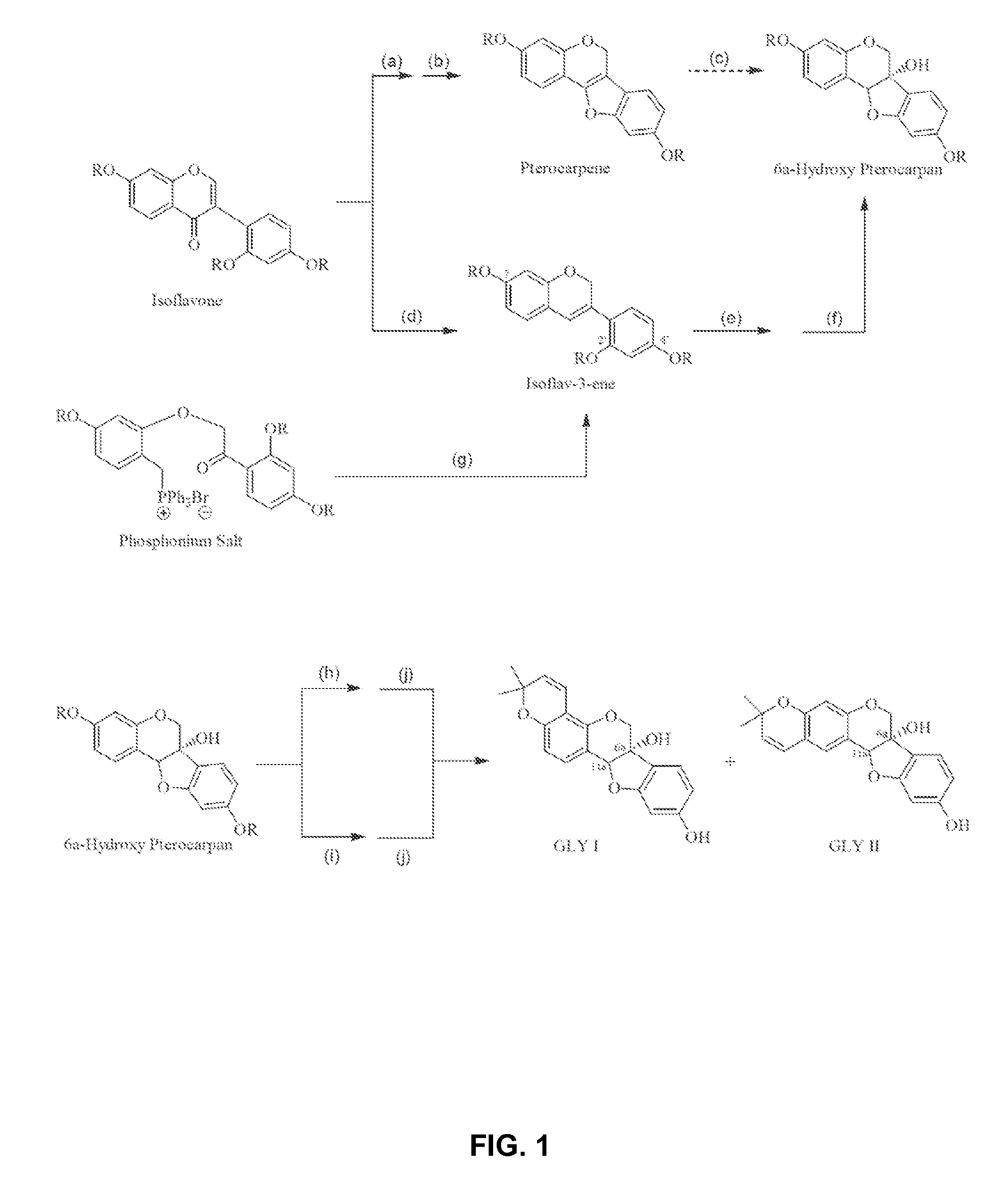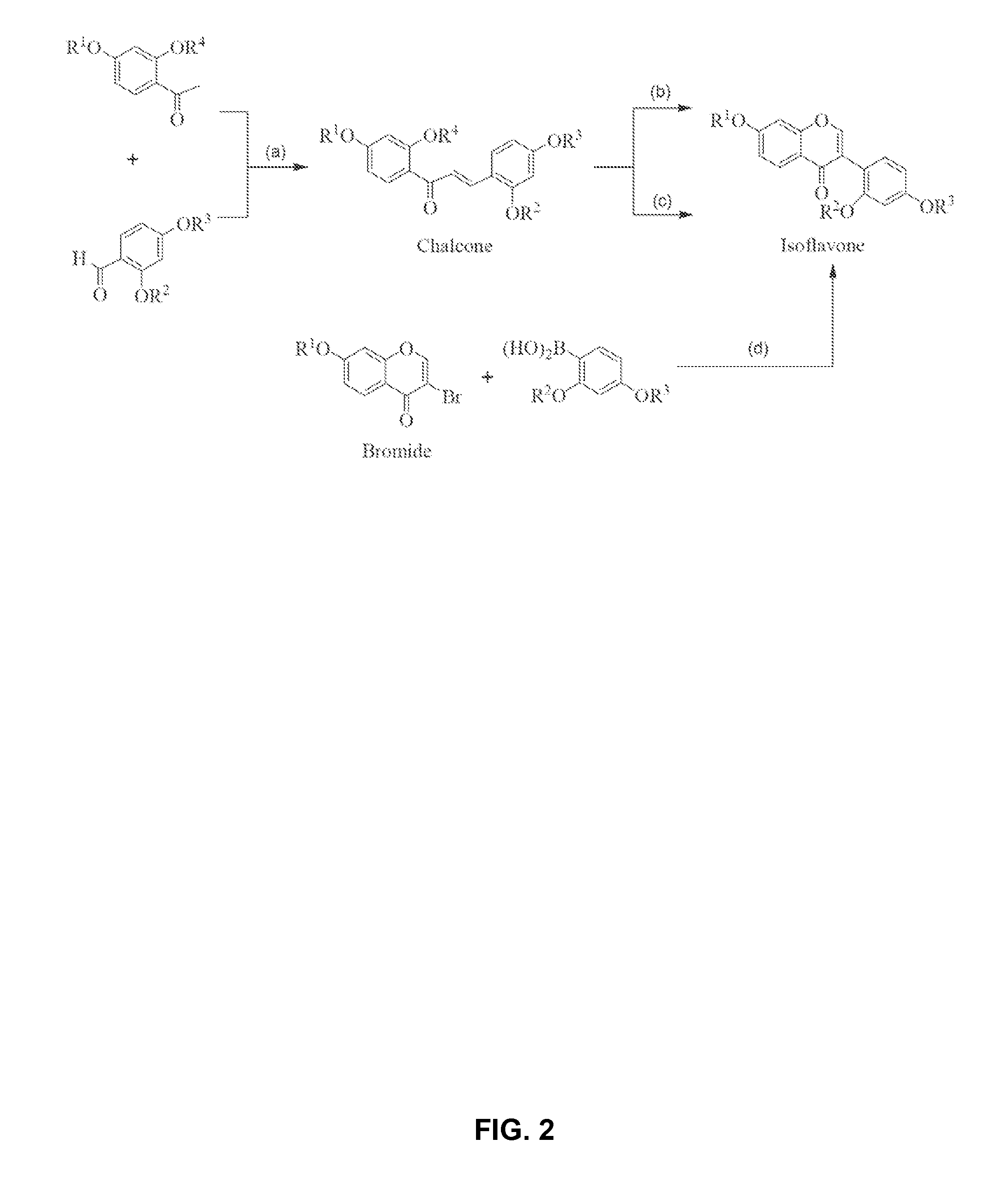Methods for synthesizing glycinols, glyceollins i and ii, compositions of selected intermediates, and therapeutic uses thereof
a technology of glycinols and compositions, applied in the direction of drug compositions, biocide, heterocyclic compound active ingredients, etc., can solve the problem of extremely low yield and achieve the effect of new compositions
- Summary
- Abstract
- Description
- Claims
- Application Information
AI Technical Summary
Benefits of technology
Problems solved by technology
Method used
Image
Examples
example 1
[0046]Synthesis of glyceollin-related isoflavones and isoflavenes via the general biomimetic route shown in Scheme 2 and in Scheme 1_(Step d) as exemplified by the case where thallium is deployed during ring closure and wherein the distinctly inventive arrangement for the protecting groups is R1═R2=Bn, R3=MOM, and R4 is initially H which is then converted to acetyl (Ac), all of which is specifically depicted in Scheme 3.
4-Benzyloxy-2-hydroxy-acetophenone
[0047]Oven-dried potassium carbonate (1.65 g, 12 mmol) was added to a solution of 2,4-dihydroxy-acetopheneone (1.52 g, 10 mmol) in 10 mL of acetonitrile and the mixture was stirred for one hour at RT. Benzylbromide (1.3 mL, 11 mmol) was added and the mixture was refluxed for 10 hours. After disappearance of 2,4-dihydroxy-acetopheneone (TLC), the solvent was evaporated to one-third volume and poured into ice water with vigorous stirring. A pinkish-white solid precipitated. The solid was recrystallized from methanol (ca. 20 mL) to obta...
example 2
[0056]Synthesis of glyceollin-related isoflavenes via the uniquely-inventive, general non-biomimetic route shown in Scheme 1 (Step g), and as specifically exemplified by the distinct display of R groups and chemical steps depicted in Scheme 4.
2-Benzyloxy-4-methoxymethyloxy-acetophenone
[0057]Oven-dried potassium carbonate (0.166 g, 1.2 mmol) was added to an ice cooled solution of 2,4-dihydroxy-acetophenone (0.152 g, 1 mmol) in 5 mL of acetone. MOMCl (0.15 mL, 2 mmol) was added drop-wise and the mixture was stirred at 0° C. for one hour. The temperature of the reaction was gradually allowed to come to RT and further stirred for 24 hours, after which it was quenched with water (ca. 10 mL). The acetone was evaporated under vacuum. The remaining water layer was extracted with DCM (2×10 mL). The organic layers were combined, dried over sodium sulfate and evaporated to obtain 0.156 g (79%) of oily product having a pink tinge. The crude product was used directly in the next step without fur...
example 3
[0065]Synthesis of the glyceollin-related 3,4-diols as exemplified by the preferred embodiments and distinct methodological steps specifically depicted in Scheme 5 (Steps a and b).
(+) 4′-(t-Butyldimethylsilyloxy)-2′,7-dibenzyloxy-isoflavan-3,4-diol
[0066]2′,7-Dibenzyloxy-4′-t-butyldimethylsilyloxy-isoflav-3-ene (0.537 g, 1 mmol) was dissolved in 10 mL of acetone and 1 mL of water was added. Methane sulfonamide (0.095 g, 1 mmol) and 4-Methylmorpholine-4-oxide i.e. NMO (0.140 g, 1.2 mmol) were then added and the resulting mixture stirred at 0° C. for 30 minutes. Osmium tetroxide solution in water (1 mL=0.004 mmol) was added slowly, upon which the reaction turned brownish-yellow. The reaction was gradually allowed to come to RT and stirred for 24 hours. After disappearance of the reactant (TLC), the reaction was quenched with 1 g of sodium bisulfate followed by evaporation of acetone. The residue was extracted with EtOAc:water (2×10 mL:10 mL). The organic layers were combined, dried ove...
PUM
| Property | Measurement | Unit |
|---|---|---|
| pH | aaaaa | aaaaa |
| temperature | aaaaa | aaaaa |
| pressure | aaaaa | aaaaa |
Abstract
Description
Claims
Application Information
 Login to View More
Login to View More - R&D
- Intellectual Property
- Life Sciences
- Materials
- Tech Scout
- Unparalleled Data Quality
- Higher Quality Content
- 60% Fewer Hallucinations
Browse by: Latest US Patents, China's latest patents, Technical Efficacy Thesaurus, Application Domain, Technology Topic, Popular Technical Reports.
© 2025 PatSnap. All rights reserved.Legal|Privacy policy|Modern Slavery Act Transparency Statement|Sitemap|About US| Contact US: help@patsnap.com



